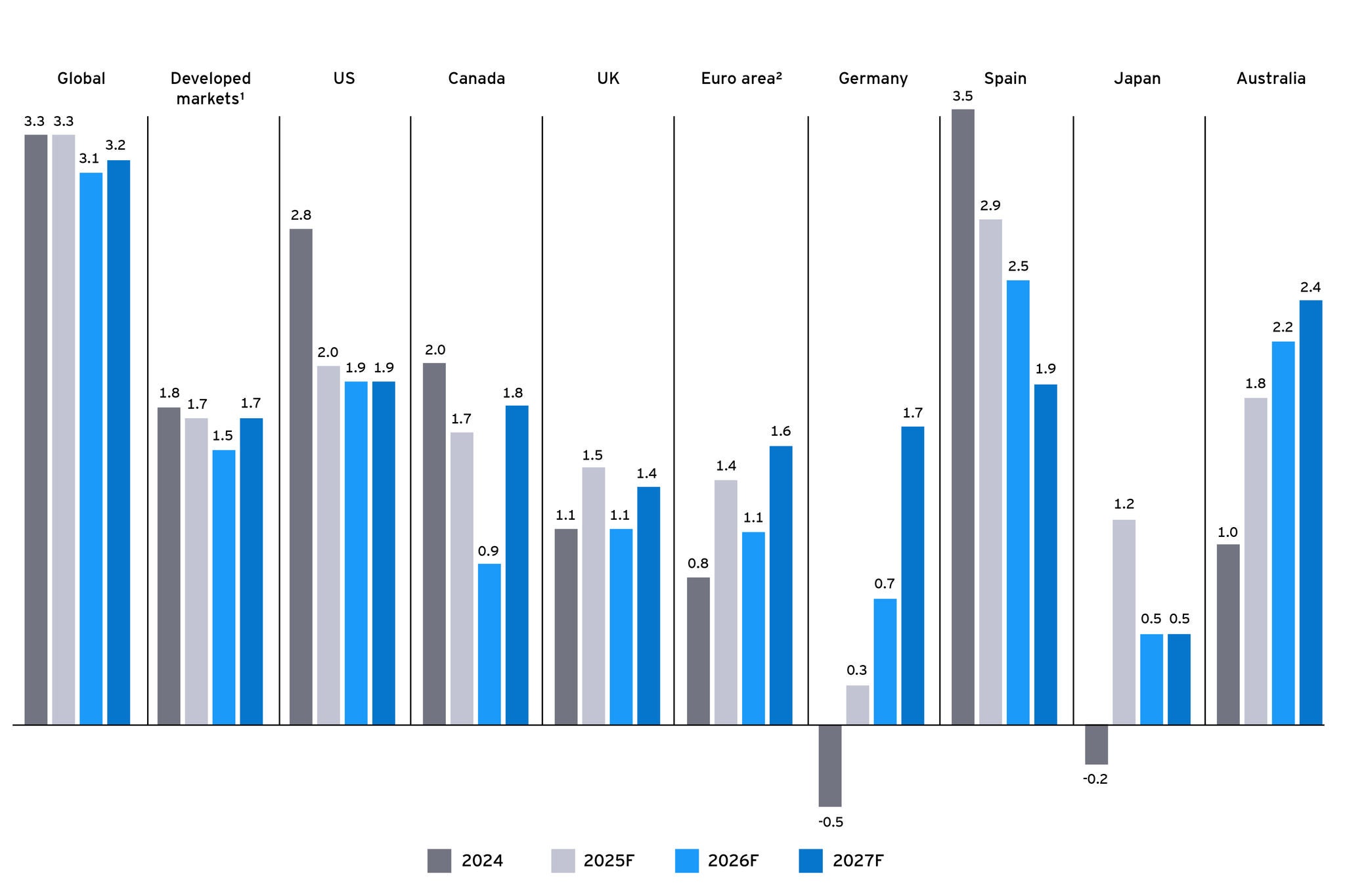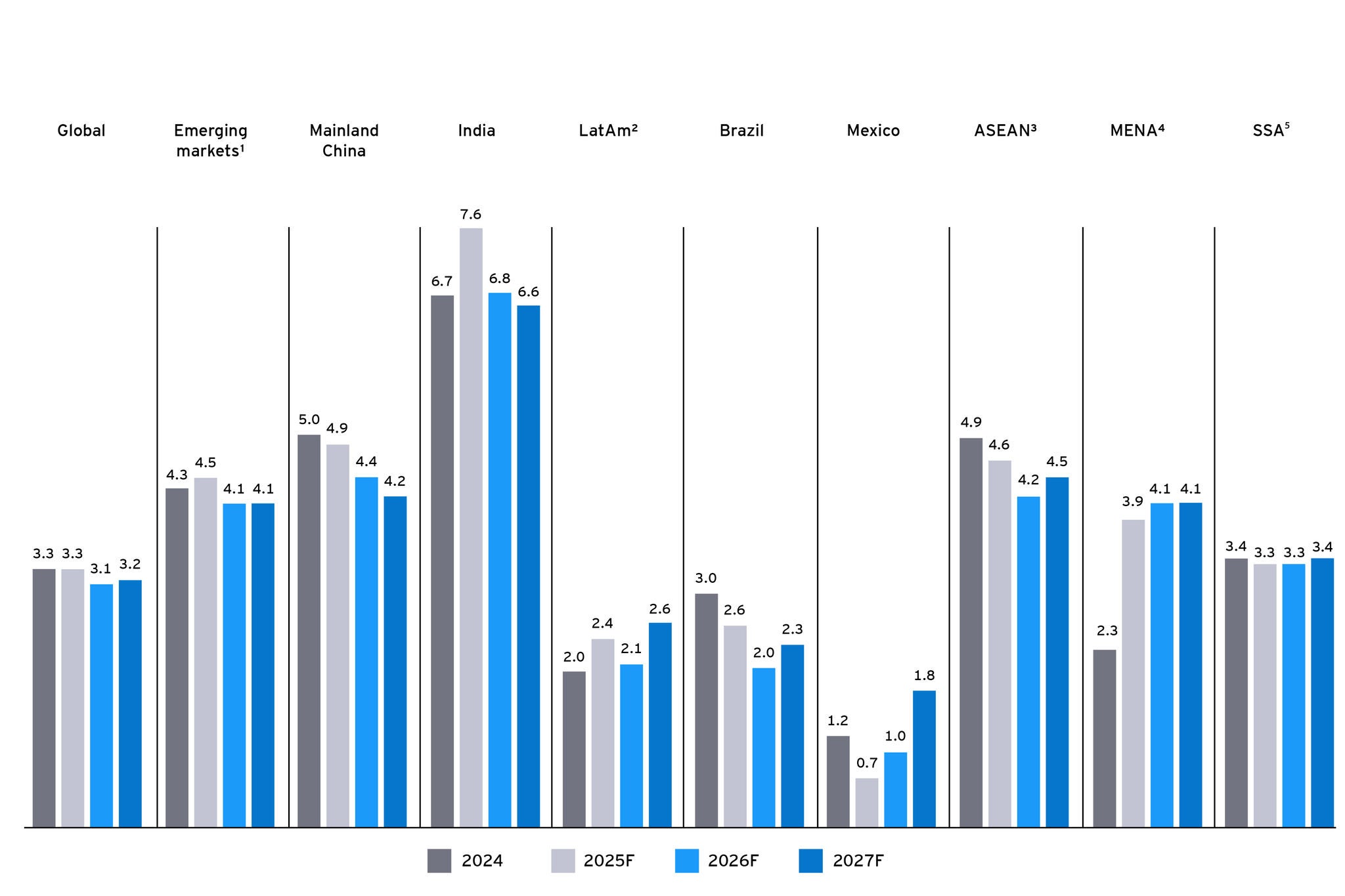Five themes will define the macro-strategic environment in 2026
1. Trade: policy-driven geoeconomic disruptions
Trade policy will remain a primary driver of supply side volatility in 2026. The average US tariff rate has risen sharply, moving from roughly 2.4% at the end of 2024 to around 16.8% by the end of November 2025, with the effective rate based on customs duties collected closer to 13%. Although the full impact of these changes is still unfolding, the scale of the increase marks a significant realignment of cost structures.
The disruption is already evident in shifting trade volumes. US-China trade is down more than 35% from a year ago, even as US trade with the rest of the world has risen 1% during that same period. These patterns reflect deliberate corporate diversification and the rerouting of supply chains to reduce exposure to China. Notably, most major US trading partners have refrained from retaliating in kind. Instead, they are pursuing negotiated pathways to lower US tariffs, often centered on commitments to expand investment rather than imposing mirror measures.
Corporate planning is adjusting to this new landscape. Firms are no longer treating elevated tariffs as a temporary shock; they are embedding them into structural cost assumptions and building greater flexibility into sourcing, pricing and capital allocation decisions. In all, we estimate the new tariff regime will reduce global GDP by roughly 0.7% by 2026 and real US GDP by 1.2% by 2026, excluding any offsets.
For business leaders, trade has become a strategic variable that actively shapes supply chain geography, input cost trajectories and competitive positioning. The priority is to diversify sourcing, build tariff contingency strategies and prepare for supply side disruptions that are likely to persist rather than fade.
2. AI revolution: innovation, investment, and labor transformation
AI is emerging as the strongest supply-side counterweight to a slowing global economy. We estimate roughly one-third of US GDP growth in the first half of 2025 to have come from AI-related investment, ranging from data center expansion and model training to cloud, semiconductor and software deployment. This acceleration is laying the foundation for a multiyear uplift. At the global level, we find that AI diffusion could generate one to two additional years of growth over the next decade, and the potential uplift for the US is even larger at two to four years as higher capital investment combines with measurable productivity gains.
At the same time, AI is generating a more bifurcated macro-strategic outlook. AI-intensive firms are driving equity market performance, with a narrow set of technology, semiconductor and cloud platform companies accounting for the majority of global stock market gains. In the US, wealth accumulation among affluent households, whose portfolios are most exposed to these sectors, is supporting discretionary spending even as broader consumption softens.
More broadly, there are questions about sustainability, particularly around return on investment, balance-sheet concentration and rapidly increasing energy demand. Together, these factors are now central to the debate over whether the current AI cycle carries elements of speculative overextension.
Labor market effects mirror this complexity. AI is delivering early productivity gains in information services, professional and business services, finance and real estate. These are sectors where digital task intensity is high and where early adoption rates are strongest. Our research along with research from the Federal Reserve Bank of St. Louis show a clear slowdown in job growth in AI-exposed occupations even as output per worker rises. This points to a mix of augmentation and displacement that is reshaping workforce requirements. The pattern is consistent with our earlier research that underscores a dual transition in which AI enhances the efficiency of high-skill roles while reducing demand for routine cognitive tasks. Research from the Federal Reserve Bank of St. Louis has similarly begun to observe quantifiable impacts of AI adoption and usage on productivity.
Taken together, AI is becoming a defining supply side force that influences capital allocation, cost structures, workforce planning and competitive positioning. The pressure to keep pace with early adopters has created a wave of fear-of-missing-out (FOMO) -driven investment, yet rapid deployment without a clear strategic framework risks misallocating capital and amplifying operational vulnerabilities.
For business leaders, the priority is to scale adoption through disciplined, productivity-enhancing pathways while carefully managing concentration risk, talent realignment and the expanding operational footprint required to support AI at scale. A holistic approach that integrates technology, workforce strategy and long-term financial planning will be far more durable than reactive investment aimed solely at maintaining appearances of competitiveness.
3. Markets in flux: shifting rates, currencies, and commodities
Financial markets remain unsettled as supply-side shocks, geoeconomic tensions and uneven central bank policy paths continue to reshape rate expectations and capital flows. A defining feature of the current environment is the widening disconnect between short-term interest rates, which still track central bank policy decisions and long-term rates, which increasingly reflect inflation expectations, fiscal trajectories and perceptions of central bank credibility. This divergence raises the risk of steeper yield curves that could persist even as central banks ease policy. For businesses, higher long-term borrowing costs would constrain investment plans and diminish the usual benefits associated with monetary accommodation.
Commodity markets are reinforcing these signals of structural strain. Recent movements in oil, rare earth metals and gold reflect a combination of geoeconomic developments, supply constraints and a broader inclination among global investors to diversify away from dollar-denominated assets. These dynamics point to a commodity landscape that is more sensitive to political shocks and more central to inflation risks than in previous cycles.
The currency backdrop is evolving, yet remains anchored by the US dollar. Despite growing concerns about fiscal sustainability, central bank independence and the potential weaponization of the dollar in geopolitical disputes, no clear alternative has emerged. The euro and yen face their own institutional and demographic constraints, and broader distrust of fiat currencies has limited confidence in rapid realignment.
Interest in stablecoins and digital currencies is rising, driven by demand for faster settlement, lower transaction costs and diversification from traditional currencies. However, these instruments remain complementary rather than competitive with the global reserve architecture, and they are not positioned to replace the dollar in the medium term. The recently passed Guiding and Establishing National Innovation for U.S. Stablecoins Act (GENIUS Act) may provide more certainty for the utilization of stablecoins.
Taken together, these forces create a financial environment that is likely to remain volatile and potentially more restrictive than underlying demand conditions might imply. For businesses, the combination of steeper yield curves, shifting commodity prices and evolving currency preferences underscores the need for stronger balance sheet planning, more adaptive hedging strategies and a more disciplined approach to investment and liquidity management.
4. Debt and deficits: competing fiscal priorities
Fiscal policy is entering a more constrained phase as high debt levels, elevated interest rates and rising structural spending needs converge. Global public debt is approaching 100% of world GDP, and fiscal deficits remain above pre-pandemic norms. In the US, the federal budget deficits are projected to average well above 6% of GDP over the coming decade, while general government debt moves past 100% of GDP. Japan remains the global outlier with debt above twice the size of its economy, and several European economies remain close to or above the 90% threshold. As debt stocks grow and interest rates stay elevated, debt service absorbs a larger share of government revenue and narrows the space for growth-enhancing investment.
This dynamic increases the likelihood that long-term borrowing costs remain high even as central banks reduce policy rates. In turn, this would limit governments’ ability to cushion future shocks and raise pressure on the private sector.
At the same time, security concerns are reshaping fiscal priorities. Global military spending has risen to its highest share of output in a decade, and many advanced economies are preparing for sustained increases as geoeconomic rivalry becomes a defining feature of international strategy. Defense is no longer a cyclical item but a structural one, set to absorb a growing share of public resources in the years ahead.
Demographic pressures are also shaping fiscal trajectories. The immediate challenge for governments is the widening mismatch between rising structural spending and limited budgetary space. Aging populations are lifting baseline commitments in health, social protection and retirement systems, yet these pressures are unfolding against the backdrop of already elevated debt and higher borrowing costs. The result is a fiscal environment in which long-term obligations are increasing just as the capacity to finance them is becoming more constrained, reinforcing the need for credible frameworks and clearer prioritization of public spending.
For policymakers, these forces create a difficult balance between supporting security, funding long-term investment and stabilizing public finances. For businesses, they signal an environment in which fiscal policy is less able to absorb shocks and where higher structural tax liabilities, more targeted incentives and greater reliance on private-sector investment are likely to define the decade ahead.
5. Demographics: evolving talent dynamics and shifting immigration patterns
Demographic change is becoming one of the most powerful structural forces shaping the global economy. The global population aged 65 and older is set to rise from roughly 10% today to nearly 20%, or 1.6 billion, by the middle of the century. This shift is unfolding alongside steadily declining fertility rates. More than two-thirds of countries now fall below the replacement rate of 2.1 births per woman, which means that working age populations will stagnate or contract across much of the world.
Labor markets are already reflecting these trends. Labor force participation is declining across most advanced economies as aging cohorts move into retirement and younger workers enter the labor market in smaller numbers. Immigration, once a reliable source of labor force growth, is becoming less effective in offsetting these pressures. Policies are tightening in many advanced economies, including the US, which is accelerating demographic slowdown at a time when businesses could face growing talent shortages.
The macroeconomic implications are far-reaching. Slower labor force growth will constrain potential output and increase the reliance on productivity gains, particularly through automation and AI-driven efficiency improvements. At the same time, aging-related spending will place sustained pressure on public finances, especially in economies where pension and health systems are already strained. Demographic shifts will also create long-term inflationary pressures in labor-intensive service sectors, where productivity growth historically lags and where rising care needs will act to amplify wage dynamics. Countries with stronger demographic profiles will attract more investment and capture larger roles in global supply chains, provided they can mobilize and upskill their workforces effectively.
For businesses, demographics are now a strategic variable that must be embedded directly into long-range planning. Persistent labor shortages reinforce the need for automation, reskilling and redesigned workforce strategies. At the same time, demographic transitions will reshape product and service demand across health care, housing, financial planning, consumer goods and mobility. Firms that adapt early to these structural changes will be better positioned to secure talent, manage cost pressures and capture emerging opportunities in an aging global economy.







